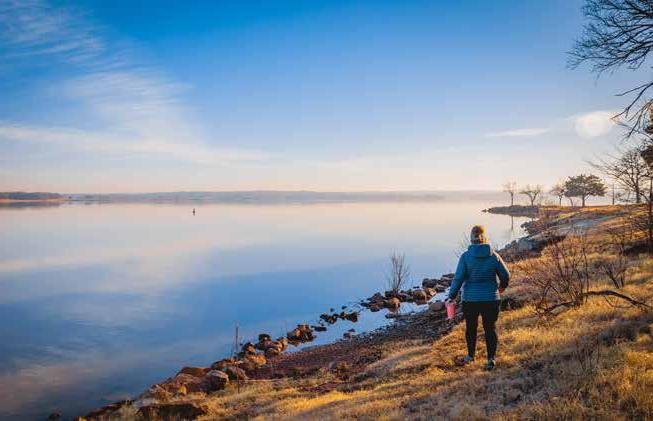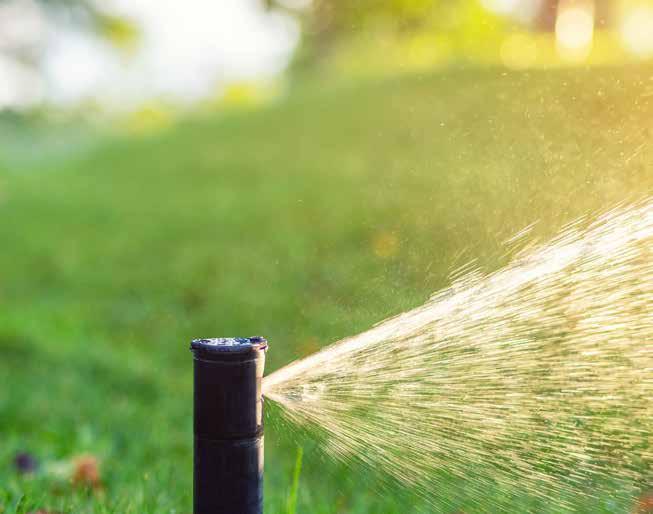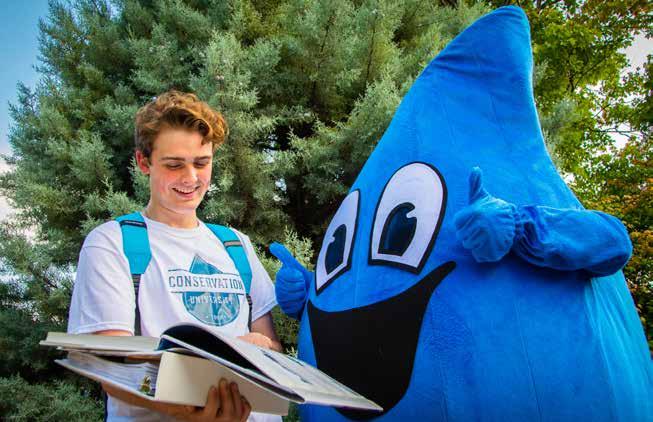
6 minute read
WATER EFFICIENCY
As Edmond’s population grows, Edmond’s water usage also increases. This is a common thread throughout most cities in the United States. To help ensure that our water supply is utilized properly, while recognizing the value of water conservation, it’s an important goal of Edmond’s Water Resources Department to examine ways to reduce water demand.
According to the Association of Central Oklahoma Governments, domestic well depths are trending deeper, but the deepest wells are getting shallower. This is due to more wells being drilled towards the edges of the aquifer in combination with drought conditions.
OKLAHOMA RAINFALL
Heavy volumes of rainfall have recently helped to offset some of the need for landscape irrigation, and it may be difficult sometimes to remember that Oklahoma will again experience periods of drought. Drought conditions bring the prospect of long-term water capacity impacts to the region.
1900 | 1910 | 1920 | 1930 | 1940 | 1950 | 1960 | 1970 | 1980 | 1990 | 2000 | 2010
ANNUAL PRECIPITATION HISTORY WITH 5-YEAR TENDENCIES OKLAHOMA STATEWIDE 1895–2018
Wetter Periods Drier Periods
TOP FIVE AND BOTTOM FIVE (FY16 to FY18)
For the City of Edmond this metric is an analysis of water consumption by each department or and/or service provided by the City. A more detailed analysis is not provided in this document, but this indicator may be used to detect deficiencies, or areas for needed improvement. Several factors went into determining the top and bottom five performers between 2016 and 2018, including the number of years a facility has been in operation. Anomalies, such as spikes in usage, are not included in determining the top and bottom five. For a more complete list of City departments, contact the Planning Department at EdmondOK.com/Sustainability.
5TOP FIVE | DECREASED WATER CONSUMPTION 65% IT Building 63% Police Support Facilities 41% Downtown Community Center 40% Animal Services 39% Vehicle Maintenance
The City’s water use for municipal operations went up in 2018. From 2016 to 2018 the City’s water consumption increased by 10.73%. Construction of a new Water Resource and Recovery Facility resulted in an anomaly where water usage spiked for those facilities. Other factors were the new Splash Pad, and increased irrigation for landscaping. These totals, particularly the City’s usage for Water/Wastewater facilities are expected to come down in future years.
5BOTTOM FIVE | INCREASED WATER CONSUMPTION 111% Irrigation– Landscape Services 62% Cross Timbers Administration Bldg. 29% Splash Pad 25% Planning and Public Works 18% City First Building
EDMOND 50 YEAR PLAN
Edmond’s 50-year water supply plan calls for “Level 1” and “Level 2” conservation options. Other similar options in the plan call for “stormwater beneficial reuse” and “non-potable” reuse. The average annual yield for Level 1 and Level 2 translates to 2,190,000,000 gallons; or 3,317 Olympic-sized swimming pools to be conserved as part of the overall strategy.
By the year 2060, Level 1 conservation options were estimated to equate to approximately 1 million gallons per day (MGD) of indoor water use savings and 1 MGD of outdoor water use savings. Primarily, these options involve education and awareness, as well as better irrigation controls. According to the 50 year water supply plan, Level 2 conservation efforts will primarily involve future rebates offered by the City on water-saving devices.
Current goals for the Water Department are to reduce potable water demand, targeting landscape irrigation in the summer, while also encouraging community involvement in other water conservation measures.

EDMOND WATER CONSERVATION
Two ways in which the City is working toward its conservation goals are to implement the City’s Mandatory Water Conservation Plan (MWCP), aimed at conserving and controlling summer water use, and to reach out to partners, such as the OSU Extension Service, who helps the City coordinate outreach activities aimed at conservation.
Edmond participates in the regional water conservation plan in an agreement with Oklahoma City. The City of Edmond implemented this plan on May 6, 2013. The following table indicates the stages now followed by the City of Edmond, with Stage 1 being the least restrictive. Along with the City of Edmond, other participating cities include Norman, Moore, Piedmont, El Reno, Yukon, Mustang, Blanchard, and the Deer Creek water district.

Click here to see our Conservation University Move-In Day video.
MANDATORY WATER CONSERVATION
City of Edmond’s Based upon Oklahoma City’s Regional Plan water conservation schedule
stage
1. Mandatory Odd/Even Lawn Watering (Effective year-round)
2. 2-Day a Week Lawn Watering
3. 1-Day a Week Lawn Watering
4. Hand Water Gardens & Flower Beds Only, Commercial Car Washes with Water Recycling Operations Only.
5. Ban on All Outdoor Watering & Washing Vehicles type of residency
All Types last number of address
Odd Even calendar date/day
Odd Even
Single-Family All Other Types Odd Even Saturday & Wednesday Sunday & Thursday Tuesday & Friday
Single-Family
Multi-Family Commercial or Gov’t. 1 or 3 5, 7 or 9 0 or 2 4, 6 or 8 -
Saturday Wednesday Sunday Thursday Tuesday Friday
What stage are we currently in?
Visit edmondwater.com/conservation or call 405.216.7775 to find out.
CONSERVATION PARTNER
The City of Edmond Water Resources Department has partnered with the OSU Cooperative Extension Service to develop educational outreach promoting outdoor water conservation. Beginning in April 2019 a series of FREE classes were provided on various outdoor water conservation topics. Additional classes are being held in 2020. Go to the City’s website under Water Conservation to find out more EdmondOK.com/Sustainability. These classes are also recorded and available on the City’s website.

2019 OUTDOOR WATER CONSERVATION CLASSES
Drought Resistant Plants for Oklahoma - Drought resistant does not mean desert landscape! Oklahoma native and welladapted plants that require minimal or no supplemental watering are discussed. These are beautiful, drought resistant plants that thrive in Oklahoma.
Rainwater Harvesting - Rainwater can be collected and stored for watering plants in the garden. This class covers how to properly size and install a rain barrel to collect water from your roof. How to increase the storage capacity of an existing system is also discussed.
Turfgrass Maintenance and Irrigation - When should you fertilize? How much water does your turfgrass need? How long should you cut your grass? These questions and more are answered.
Home Irrigation Checkup - Smart Irrigation Month is an initiative to promote outdoor water use efficiency during peak summer demand. Outdoor water use makes up about 30% of overall water use in the United States, and up to 50% of this water is wasted. During this workshop you learn how to complete a simple home irrigation checkup to ensure your system is functioning efficiently.
Dealing with Difficult Shady Areas - Shady areas can make it difficult to grow a healthy lawn, but there are many ways to find success in the shade. Common problems and solutions are addressed, as well as alternatives to traditional turfgrass.
Smart Irrigation Checkup - Smart irrigation technology can help homeowners to apply the right amount of water to their landscape and maximize system efficiency. The workshop discusses smart irrigation controllers, soil moisture sensors, rain/freeze sensors, and pressure reducing spray heads.
Composting - Compost is a natural, dark brown, humus-rich material formed from the decomposition or breakdown of organic materials such as leaves, grass clippings, and vegetable food scraps. Composting reduces the flow of material to the landfill and provides an excellent source of nutrients for your garden. Procedures for composting are discussed, along with options for establishing a compost container, bin, or pile.

